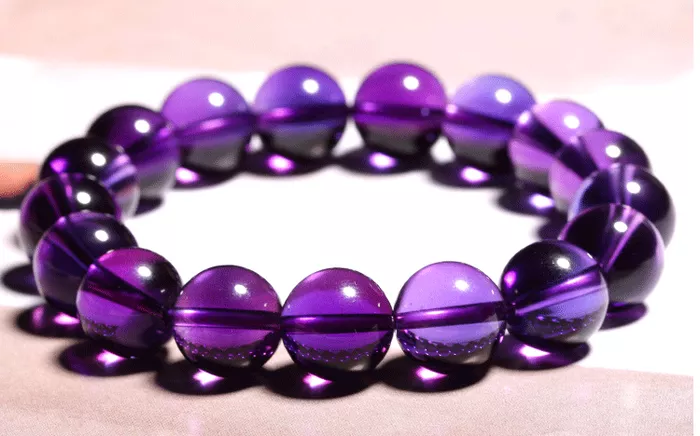Jewelry appraisal is not just about evaluating the monetary value of precious stones and metals; it’s also about understanding the intricate details that give each piece its unique charm and color. Today, we’ll delve into the fascinating world of amethyst, a gemstone that has captivated people for centuries with its enchanting purple hues. But how does amethyst get its color? Let’s explore this question in detail.
The Formation of Amethyst
Amethyst is a variety of quartz, a common mineral found in igneous, metamorphic, and sedimentary rocks. Quartz itself is composed of silicon dioxide (SiO2) and is one of the most abundant minerals on Earth. However, what sets amethyst apart from other quartz varieties is its stunning purple color. This coloration is the result of a complex set of geological processes and chemical reactions.
Quartz crystals often form under high-temperature and high-pressure conditions, such as those found in volcanic rocks or metamorphic belts. As magma cools and solidifies, it can trap gases and minerals within the crystal structure. These impurities can play a crucial role in determining the color of the quartz.
The Role of Trace Elements
The purple color of amethyst is primarily due to the presence of trace elements within the quartz crystal. Specifically, it’s the result of iron (Fe) and manganese (Mn) impurities. These elements substitute for silicon atoms in the quartz lattice, causing a slight distortion in the crystal structure. This distortion leads to the absorption of certain wavelengths of light, resulting in the reflection of purple hues.
However, it’s not just the presence of these elements that determines the color intensity and shade of amethyst. The concentration, distribution, and bonding state of these impurities also play a significant role. For example, a higher concentration of iron can result in a deeper purple color, while manganese can contribute to a more reddish or lavender hue.
The Influence of Geological Processes
The geological processes that form amethyst also play a crucial role in determining its color. Quartz crystals can undergo various transformations during metamorphism, such as recrystallization and pressure-induced deformation. These processes can alter the distribution and concentration of trace elements within the crystal, thereby affecting its color.
In addition, the temperature and pressure conditions during the formation of amethyst can also influence its color. For instance, higher temperatures can cause the diffusion of impurities within the crystal, leading to a more uniform color distribution. Conversely, rapid cooling can trap impurities in specific regions, resulting in color zoning or banding within the crystal.
The Impact of Heat Treatment
Human intervention, particularly heat treatment, can also alter the color of amethyst. Heat treatment is a common practice in the gemstone industry to enhance the color or clarity of gemstones. In the case of amethyst, heat treatment can cause the redistribution of trace elements within the crystal, leading to a more intense or uniform purple color.
During heat treatment, amethyst is exposed to high temperatures in a controlled environment. This process can cause the impurities to diffuse more evenly within the crystal, reducing color zoning and enhancing the overall appearance. However, it’s important to note that heat-treated amethyst is still considered natural, as the process does not introduce any foreign substances into the gemstone.
The Uniqueness of Each Amethyst
Despite the common factors that contribute to its color, each amethyst gemstone is unique. The concentration, distribution, and bonding state of trace elements can vary significantly from one crystal to another, resulting in a wide range of color shades and intensities. This uniqueness is what makes amethyst such a captivating gemstone, with each piece exhibiting its own distinct characteristics.
Moreover, the cutting and polishing of amethyst can also affect its color appearance. The angle and orientation of the cut can enhance or diminish certain color tones, while the quality of the polish can impact the gemstone’s brilliance and clarity.
Popular Science Perspective
From a popular science perspective, the color of amethyst is a fascinating example of how geology, chemistry, and physics interact to create natural beauty. The presence of trace elements such as iron and manganese, combined with the unique geological processes that form quartz crystals, results in a stunning purple gemstone that has captivated people for thousands of years.
Heat treatment, a common practice in the gemstone industry, further demonstrates how human ingenuity can enhance the natural beauty of gemstones. By carefully controlling the heat treatment process, gemologists can optimize the color and clarity of amethyst, making it even more appealing to jewelry enthusiasts.
In addition to its aesthetic appeal, amethyst has also been revered for its spiritual and healing properties. Throughout history, people have believed that amethyst can protect against intoxication, bring clarity to the mind, and promote inner peace. While these beliefs may not be scientifically proven, they add to the allure of this unique gemstone.
Conclusion
In conclusion, the color of amethyst is the result of a complex interplay of geological processes, trace elements, and human intervention. From the high-temperature and high-pressure conditions that form quartz crystals to the trace elements that give amethyst its purple hue, each factor contributes to the unique charm of this gemstone.
Related topic:


